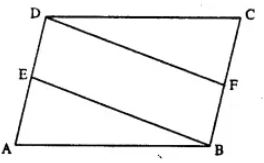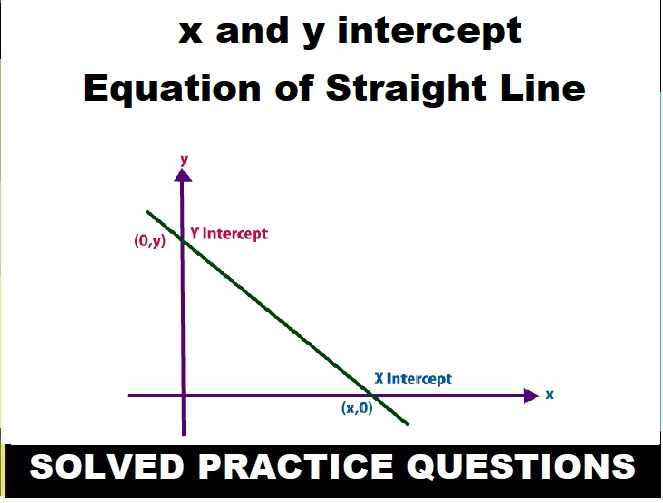Special Types Quadrilaterals ICSE Class-8th Concise Selina Mathematics Solutions Chapter-17 . We provide step by step Solutions of Exercise / lesson-17 Special Types Quadrilaterals for ICSE Class-8 Concise Selina Mathematics. Our Solutions contain all type Questions of Exe-17 to develop skill and confidence . Visit official Website CISCE for detail information about ICSE Board Class-8 Mathematics.
Special Types Quadrilaterals ICSE Class-8th Concise Selina Mathematics Solutions Chapter-17
Exercise – 17
Question 1.
In parallelogram ABCD, ∠A = 3 times ∠B. Find all the angles of the parallelogram. In the same parallelogram, if AB = 5x – 7 and CD = 3x +1 ; find the length of CD.
Answer

AB = CD
5x – 7 = 3x + 1
⇒ 5x – 3x = 1+7
⇒ 2x = 8
⇒ x = 4
CD = 3 x 4+1 = 13
Hence 135°, 45°, 135° and 45° ; 13
Question 2.
In parallelogram PQRS, ∠Q = (4x – 5)° and ∠S = (3x + 10)°. Calculate : ∠Q and ∠R.
Answer

Question 3.
In rhombus ABCD ;
(i) if ∠A = 74° ; find ∠B and ∠C.
(ii) if AD = 7.5 cm ; find BC and CD.
Answer

Question 4.
In square PQRS :
(i) if PQ = 3x – 7 and QR = x + 3 ; find PS
(ii) if PR = 5x and QR = 9x – 8. Find QS
Answer

As diagonals of square are equal.
PR = QS
5x = 9x – 8
⇒ 5x – 9x = -8
⇒ -4x = -8
⇒ x = 2
QS = 9x – 8 = 9 x 2 – 8 =10
Question 5.
ABCD is a rectangle, if ∠BPC = 124°
Calculate : (i) ∠BAP (ii) ∠ADP

Answer
Diagonals of rectangle are equal and bisect each other.
∠PBC = ∠PCB = x (say)
But ∠BPC + ∠PBC + ∠PCB
= 180°
124° + x + x
= 180°
2x = 180° – 124°
2x = 56°
⇒ x = 28°
∠PBC = 28°
But ∠PBC = ∠ADP
[Alternate ∠s]
∠ADP = 28°
Again ∠APB = 180° – 124°
= 56°
Also PA = PB
∠BAP =1/2(180° – ∠APB)
= (1/2) x (180°- 56°)
= (1/2)×124° = 62°
Hence
(i) ∠BAP = 62° (
ii) ∠ADP =28°
Question 6.
ABCD is a rhombus. If ∠BAC = 38°, find :
(i) ∠ACB
(ii) ∠DAC
(iii) ∠ADC.

Answer
ABCD is Rhombus (Given)
AB = BC
∠BAC = ∠ACB
(∠s opp. to equal sides)
But ∠BAC = 38° (Given)
∠ACB = 38°
In ∆ABC,
∠ABC + ∠BAC + ∠ACB
= 180°
∠ABC + 38°+ 38°
= 180°
∠ABC = 180° – 76°
= 104°
But ∠ABC = ∠ADC (opp. ∠s of rhombus)
∠ADC = 104°
∠DAC = ∠DCA ( AD = CD)
∠DAC = (1/2) [180° – 104°]
∠DAC = (1/2)× 76°
= 38°
Hence
(i) ∠ACB = 38°
(ii) ∠DAC = 38°
(iii) ∠ADC = 104° Ans.
Question 7.
ABCD is a rhombus. If ∠BCA = 35°. find ∠ADC.
Answer

Question 8.
PQRS is a parallelogram whose diagonals intersect at M.
If ∠PMS = 54°, ∠QSR = 25° and ∠SQR = 30° ; find :
(i) ∠RPS
(ii) ∠PRS
(iii) ∠PSR.
Answer
Given :
||gm PQRS in which diagonals PR & QS intersect at M.
∠PMS = 54° ; ∠QSR = 25° and ∠SQR=30°

To find :
(i) ∠RPS
(ii) ∠PRS
(iii) ∠PSR
Proof :
QR || PS
⇒ ∠PSQ = ∠SQR (Alternate ∠s)
But ∠SQR = 30° (Given)
∠PSQ = 30°
In ∆SMP,
∠PMS + ∠ PSM +∠MPS
= 180° or 54° + 30° + ∠RPS
= 180°
∠RPS = 180°- 84°
= 96°
Now ∠PRS + ∠RSQ = ∠PMS
∠PRS + 25° =54°
∠PRS = 54° – 25°
= 29°
∠PSR = ∠PSQ + ∠RSQ = 30°+25°
= 55°
Hence
(i) ∠RPS = 96°
(ii) ∠PRS = 29°
(iii) ∠PSR = 55°
Question 9.
Given : Parallelogram ABCD in which diagonals AC and BD intersect at M.
Prove : M is mid-point of LN.
Answer

Question 10.
In an Isosceles-trapezium, show that the opposite angles are supplementary.
Answer

Question 11.
ABCD is a parallelogram. What kind of quadrilateral is it if :
(i) AC = BD and AC is perpendicular to BD?
(ii) AC is perpendicular to BD but is not equal to it?
(iii) AC = BD but AC is not perpendicular to BD?
Answer


Question 12.
Prove that the diagonals of a parallelogram bisect each other.
Answer

Question 13.
If the diagonals of a parallelogram are of equal lengths, the parallelogram is a rectangle. Prove it.
Answer

Question 14.
In parallelogram ABCD, E is the mid-point of AD and F is the mid-point of BC. Prove that BFDE is a parallelogram.
Answer

Given:
Parallelogram ABCD in which E and F are mid-points of AD and BC respectively.
To Prove:
BFDE is a Parallelogram.
Proof:
E is the mid-point of AD. (Given)
DE = AD
Also, F is mid-point of BC (Given)
BF = BC
But AD = BC
(opp. sides of parallelogram)
BF = DE
Again AD || BC
=> DE || BF
Now DE || BF and DE
= BF
Hence BFDE is a parallelogram.
Question 15.
In parallelogram ABCD, E is the mid-point of side AB and CE bisects angle BCD. Prove that :
(i) AE = AD,
(ii) DE bisects and ∠ADC and
(iii) Angle DEC is a right angle.
Answer

DE bisects ∠ADC.
Now AD || BC
=> ∠D + ∠C = 180°
2∠6+2∠1 = 180°
DE and CE are bisectors.
∠6 + ∠1 = 180°/2
∠6 + ∠1 = 90°
But ∠DEC + ∠6 + ∠1 = 180°
∠DEC + 90° = 180°
∠DEC = 180° – 90°
∠DEC = 90°
Hence the result.
Question 16.
In the following diagram, the bisectors of interior angles of the parallelogram PQRS enclose a quadrilateral ABCD.

Show that:
(i) ∠PSB + ∠SPB = 90°
(ii) ∠PBS = 90°
(iii) ∠ABC = 90°
(iv) ∠ADC = 90°
(v) ∠A = 90°
(vi) ABCD is a rectangle
Thus, the bisectors of the angles of a parallelogram enclose a rectangle.
Answer
Given:
In parallelogram ABCD bisector of angles P and Q, meet at A, bisectors of ∠R and ∠S meet at C. Forming a quadrilateral ABCD as shown in the figure.
To prove :
(i) ∠PSB + ∠SPB = 90°
(ii) ∠PBS = 90°
(iii) ∠ABC = 90°
(iv) ∠ADC = 90°
(v) ∠A = 9°
(vi) ABCD is a rectangle
Proof :
In parallelogram PQRS,
PS || QR (opposite sides)
∠P +∠Q = 180°
and AP and AQ are the bisectors of consecutive angles
∠P and ∠Q of the parallelogram
∠APQ + ∠AQP = 12 x 180° = 90°
But in ∆APQ,
∠A + ∠APQ + ∠AQP = 180° (Angles of a triangle)
∠A + 90° = 180°
∠A = 180° – 90°
(i) ∠A = 90°
Similarly PQ || SR
∠PSB + SPB = 90°
(ii) and ∠PBS = 90°
But, ∠ABC = ∠PBS (Vertically opposite angles)
(iii) ∠ABC = 90°
Similarly we can prove that
(iv) ∠ADC = 90° and ∠C = 90°
(vi) ABCD is a rectangle (Each angle of a quadrilateral is 90°)
Hence proved.
Question 17.
In parallelogram ABCD, X and Y are midpoints of opposite sides AB and DC respectively. Prove that:
(i) AX = YC
(ii) AX is parallel to YC
(iii) AXCY is a parallelogram.
Answer
Given:
In parallelogram ABCD, X and Y are the mid-points of sides AB and DC respectively AY and CX are joined.

To prove :
(i) AX = YC
(ii) AX is parallel to YC
(iii) AXCY is a parallelogram
Proof:
AB || DC and X and Y are the mid-points of the sides AB and DC respectively
(i) AX = YC (of opposite sides of a parallelogram)
(ii) AX || YC
(iii) AXCY is a parallelogram (A pair of opposite sides are equal and parallel)
Hence proved.
Question 18.
The given figure shows a parallelogram ABCD. Points M and N lie in diagonal BD such that DM = BN.

Prove that:
(i) ∆DMC = ∆BNA and so CM = AN
(ii) ∆AMD = ∆CNB and so AM CN
(iii) ANCM is a parallelogram.
Answer
Given:
In parallelogram ABCD, points M and N lie on the diagonal BD such that DM = BN
AN, NC, CM and MA are joined
To prove :
(i) ∆DMC = ∆BNA and so CM = AN
(ii) ∆AMD = ∆CNB and so AM = CN
(iii) ANCM is a parallelogram
Proofed :
(i) In ∆DMC and ∆BNA.
CD = AB
(opposite sides of ||gm ABCD)
DM = BN (given)
∠CDM = ∠ABN
(alternate angles)
∆DMC = ∆BNA
(SAS axiom)
CM =AN (c.p.c.t.)
Similarly, in ∆AMD and ∆CNB
AD = BC
(opposite sides of ||gm)
DM = BN (given)
∠ADM = ∠CBN – (alternate angles)
∆AMD = ∆CNB (SAS axiom)
AM = CN (c.p.c.t.)
(iii) CM = AN and AM = CN (proved)
ANCM is a parallelogram (opposite sides are equal)
Hence proved.
Question 19.
The given figure shows a rhombus ABCD in which angle BCD = 80°. Find angles x and y.

Answer
In rhombus ABCD, diagonals AC and BD bisect each other at 90°
∠BCD = 80°
Diagonals bisect the opposite angles also ∠BCD =
∠BAD (Opposite angles of rhombus)
∠BAD = 80° and ∠ABC = ∠ADC = 180° – 80° = 100°
Diagonals bisect opposite angles
∠OCB or ∠PCB = (80°/2) = 40°
In ∆PCM,
Ext. CPD = ∠OCB + ∠PMC
110° = 40° + x
⇒ x = 110° – 40° = 70°
and ∠ADO = 1/2 ∠ADC = (1/2)×100°=50°
Hence x = 70° and y = 50°
Question 20.
Use the information given in the alongside diagram to find the value of x, y and z.

Answer
ABCD is a parallelogram and AC is its diagonal which bisects the opposite angle
Opposite sides of a parallelogram are equal
3x + 14 = 2x + 25
⇒ 3x – 2x = 25 – 14
⇒ x = 11
∴ x = 11 cm
∠DCA = ∠CAB (Alternate angles)
y + 9° = 24
y = 24° – 9° = 15°
∠DAB = 3y° + 5° + 24° = 3 x 15 + 5 + 24° = 50° + 24° = 74°
∠ABC =180°- ∠DAB = 180° – 74° = 106°
z = 106°
Hence x = 11 cm, y = 15°,
z = 106°
Question 21.
The following figure is a rectangle in which x : y = 3 : 7; find the values of x and y.

Answer
ABCD is a rectangle,
x : y = 3 : 1
In ∆BCE, ∠B = 90°
x + y = 90°
But x : y = 3 : 7
Sum of ratios = 3 + 7=10
∴x=90∘×310=27∘
and y = 90∘×710=63∘
Hence x = 27°, y = 63°

Question 22.
In the given figure, AB || EC, AB = AC and AE bisects ∠DAC. Prove that:

(i) ∠EAC = ∠ACB
(ii) ABCE is a parallelogram.
Answer
ABCE is a quadrilateral in which AC is its diagonal and
AB || EC, AB = AC
BA is produced to D
AE bisects ∠DAC
To prove:
(i) ∠EAC = ∠ACB
(ii) ABCE is a parallelogram
Proof:
(i) In ∆ABC and ∆ZAEC
AC=AC (common)
AB = CE (given)
∠BAC = ∠ACE (Alternate angle)
∆ABC = ∆AEC (SAS Axiom)
(ii) ∠BCA = ∠CAE (c.p.c.t.)
But these are alternate angles
AE || BC
But AB || EC (given)
Hence –
so ABCD is a parallelogram
— End of Special Types Quadrilaterals Solutions :–
Return to – Concise Selina Maths Solutions for ICSE Class -8


